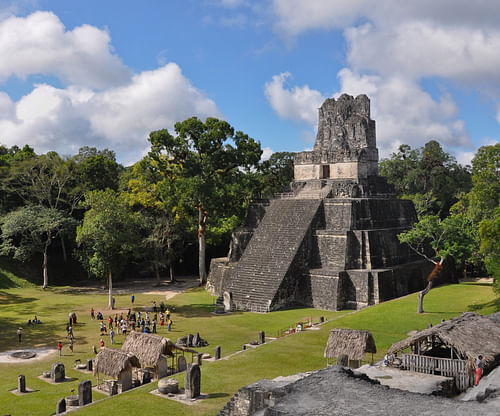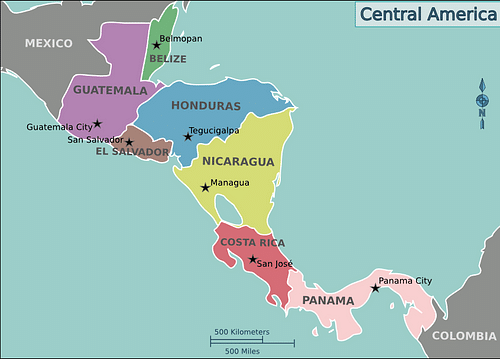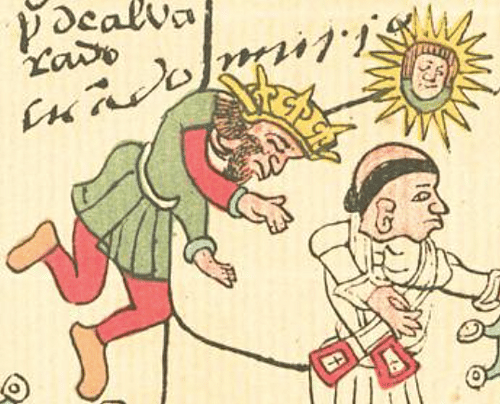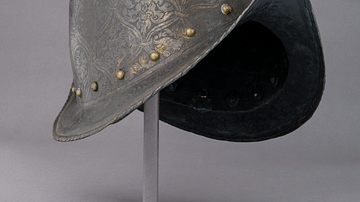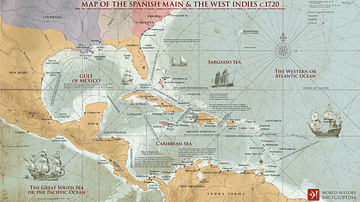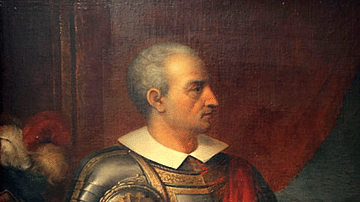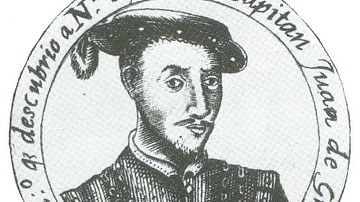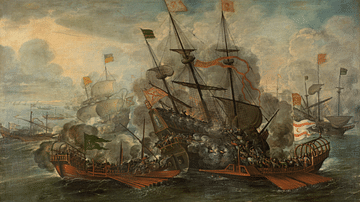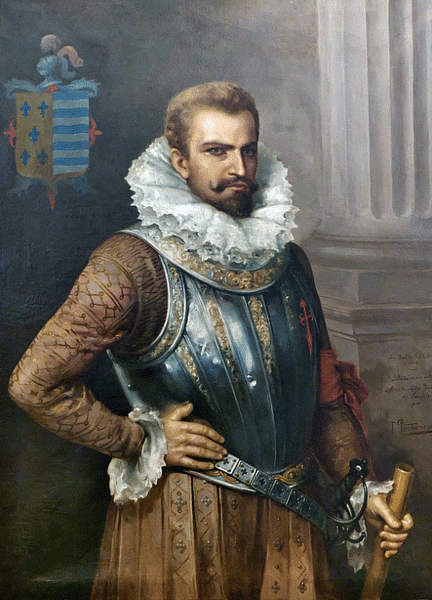
Pedro de Alvarado (c. 1485-1541) was a Spanish conquistador who became the first governor of Guatemala in 1527. Living an extraordinary life of adventure, Alvarado participated in separate expeditions to Mexico, Central America, South America, and finally, North America. He is best known today for leading the conquistadors who defeated the Quiché and Cakchiquel Maya.
Alvarado was Hernán Cortés' second-in-command during the conquest of the Aztec Empire in Mexico in 1520. He then moved on to attack Guatemala and other parts of Central America before launching an expedition to Ecuador. Still fighting indigenous peoples into his 50s, Alvarado died in Mexico in 1541, having gained a life-long reputation for being one of the most ruthless and cruellest of all conquistadors, a highly competitive field for such a dishonour.
Early Life
Pedro de Alvarado y Mesía was born around 1485 in Badajoz, Spain. Alvarado first came to prominence when he voyaged to Spain's first colony in the Americas, Hispaniola (modern Dominican Republic/Haiti) in the Caribbean in 1510. In 1518, he was part of the expedition sent by Diego Velázquez de Cuéllar (1465-1524), the Governor of Cuba, to explore the Yucatán Peninsula. The group of conquistadors ('conquerors') was led by Juan de Grijalva (1489-1527), who Alvaredo did not get on with and whom he denounced to Velázquez.
Alvarado is given the following physical description by the celebrated Spanish chronicler Bernal Diáz (b. 1492) in his The Conquest of New Spain:
In every sense beautifully proportioned in body, noble in his gait…very pleasing features, and an amiable manner of expressing himself, so that there always appeared a smile on his countenance.
(Sheppard, 23)
In contrast to his pleasant physique, historians have been queueing up ever since to describe Alvarado's approach to conquest in far less flattering terms. The historian S. Sheppard gives a typical description of Alvarado as "impetuous, cruel, and utterly amoral" (ibid). Even his own men, largely ruthless cutthroats themselves, denounced Alvarado for his brutality.
Mexico & the Aztecs
Alvarado was a professional soldier and second-in-command of the expedition led by Cortés which landed on the Mexican coast in 1519. Cortés and his conquistadors made their way to Tenochtitlan, the capital of the Aztec civilization, after first defeating the Tlaxcalans. The Tlaxacalans then became allies when Cortés promised them spoils from victory over the Aztecs (aka Mexica). To seal the alliance, the Tlaxcala military leader Xicotencatl betrothed his daughter to Alvarado, who, because of his red-blonde hair and matching beard had gained the nickname Tonatiuh, the sun god. Perhaps the nickname also had something to do with the perpetual glint from the bling Alvarado was famous for wearing: a flashing diamond ring and jewelled necklace.
The Spanish used their superior weapons, cavalry and thousands of indigenous allies to conquer Tenochtitlan. When Cortés left to face a rival group of conquistadors just landed at Veracruz, Alvarado was left in charge of Tenochtitlan with 120 Spaniards and the Tlaxacalan allies. This was a grave error of Cortés', perhaps his most significant in the Americas. Alvarado and his men proved rather insensitive to Aztec conventions when they unwisely attempted to interrupt the annual festival of Tóxcatl, which honoured Tezcatlipoca with the sacrifice of an impersonator dressed as the god. Perhaps Alvarado had misread the ceremony as the beginnings of an uprising, and he followed his own maxim: "He who begins the battle, wins." Alvarado had set up a number of harquebusiers and sealed off the passageways to the ceremonial square in question. First, the chief Aztec drummer was attacked; the Spanish cut off his arms and then his head. Next, everyone else was systematically butchered. The result was a massacre of many of the Aztec nobility and priesthood, which in turn brought about precisely what Alvarado had feared: a popular uprising. Several of the Spaniards were killed in the ensuing chaos, and Alvarado was wounded in the face by a stone.
Fortunately for Alvarado, Cortés then returned to the capital, having persuaded the newly landed conquistadors to join him. Cortés demanded an explanation from Alvarado for his actions which had aroused the entire city to a state of frenzy, and he was not satisfied with Alvarado's excuse that the strike had been carried out as a preemptive one. When Cortés instructed the captive Aztec ruler Motecuhzoma to speak before his people and calm them, he was struck down by a rock. There was nothing to do but retreat from the city until the situation calmed. The bloody withdrawal of 30 June became known as the Noche Triste ('Sad Night'). The Spaniards extricated themselves using temporary wooden bridges built for the challenging task of crossing the city's many canals. Alvarado was charged with leading the rearguard and only managed to escape by making a prodigious leap over a canal. The price of freedom was high. Cortés lost half his men, most of his best horses, and all of the eight tons of loot he had been accumulating ever since he arrived in Mesoamerica.

The Spanish returned to besiege Tenochtitlan and finally captured the city on 13 August 1521. Alvarado was made the city's first mayor-magistrate or alcalde. The conquistadors then proceeded to ruthlessly subdue the rest of Mesoamerica. They called their vast new colony New Spain, and Alvarado was charged with 'pacifying' the city of Tehuantepec and the surrounding region of Oaxaca.
Guatemala & the Maya
In December 1523, Alvarado led a land expedition to explore the southern part of Mexico and beyond. The idea was to eventually link up with a fleet led by Cristóbal de Olid and so thoroughly incorporate this part of Central America into the colony of New Spain. Reaching Guatemala in 1524, Alvarado was able to take advantage of the smallpox epidemic that had swept through the region before they had even arrived and the ongoing conflict between two groups of Maya: the Quiché (aka K'iche') and Cakchiquel (aka Kaqchikel).
First siding with the Cakchiquel, Alvarado used his new allies to defeat a Quiché army of some 30,000 warriors (if Alvarado's account is to be believed) in July 1524 at a battle near Xelajú in the western highlands. This victory was topped, at least in legend, by Alvarado personally engaging the Quiché leader Tecúm Umán (aka Tecun Umán) in hand-to-hand combat. Alvarado later claimed that his leg had been pierced through by an arrow of Tecúm Umán's, which pinned him to his saddle. The Spaniard, nevertheless, won the four-hour duel, and Xelajú was renamed Quezaltenango. The Quiché capital of Utatlan was burnt to the ground.
Next turning against the Cakchiquel, Alvarado quashed a revolt and established the first Spanish settlement in the region in July 1524, Santiago los Caballeros de Guatemala. Estates were handed out by Alvarado to his followers. The Cakchiquel were far from defeated, though, and they continued to resist Spanish domination until 1530. The fragmented political setup of the Maya civilization meant that conquering one city had little effect on the neighbouring one, and the Spanish were obliged to fight for every piece of this part of Mesoamerica. In addition, the Maya were much more used to fighting guerrilla warfare than the Aztecs or Incas. Alvarado and his conquistadors had to face night attacks, ambushes, traps, and an almost invisible enemy that frequently melted away into the dense jungle to fight another day. It was these difficulties that necessitated, in 1527, moving the capital to the foot of the Agua volcano in the Almolonga Valley on the site of what is now Ciudad Vieja. Eventually, though, the use of indigenous allies tipped the scales and finally saw the Maya defeated. This fact of inside help was not recognised by the Spanish chroniclers at the time, eager as they were to demonstrate what they considered their own military and moral superiority.
El Salvador & the Pipiles
Meanwhile, Alvarado had pressed on deeper south in June 1524 into what is today El Salvador. He defeated the Pipiles Indians at a battle near Acajutla but did not manage to control the region. The rainy season was not helpful, and two fortified cities, Cuscatlán and Izalco stood firm against Spanish attacks. Alvarado was badly wounded in the campaign, struck by an arrow in the thigh.
In 1525, another expedition, this time led by Alvarado's brother Gonzalo, defeated the Pipiles again and then built over their capital of Cuscatlán, establishing San Salvador. The Pipiles remained determined to hold on to their lands and attacked San Salvador, effectively wiping out the Spanish settlement within a year. In 1526, Pedro de Alvarado returned himself with a punitive expedition and sent a fourth in 1528 when the Pipiles were finally and brutally quashed (although some pockets of resistance remained active until 1539).
Besides battling local populations, the conquistadors were in constant competition amongst themselves, and Alvarado's great rival turned out to be Pedro Arias de Ávila (aka Pedrarias Ávila, 1442-1531). Through intrigue and execution, Pedrarias had usurped the position of Vasco Núñez de Balboa (1475-1519) to become Panama's foremost Spaniard. He sent an expedition northwards to increase his own sphere of control, which it achieved, thanks to Alvarado being obliged to return to Guatemala to deal with the ongoing Cakchiquel rebellion.
Alvarado was made a Knight of Santiago, given the status of adelantado (right of conquest), and granted the governorship of Guatemala in 1527, which controlled within its jurisdiction El Salvador. The region now made up a distinct part of the Spanish Empire on the American mainland, but Guatemala did not receive any formal apparatus of government until 1542. Not giving up on the still disputed territory between Guatemala and Panama, Alvarado had sent his brother Jorge to successfully recapture El Salvador from the clutches of Pedrarias and the Pipiles in 1528. As a result of this territorial gain, the settlement of San Salvador was relocated south to the Valley of La Bermuda, and Jorge Alvarado became the ruler of an indigenous population now greatly reduced by diseases of European origin. Pedro de Alvarado remained governor of Guatemala until 1531, but the lack of precious metals in the region meant that Alvarado was keen to explore what lay to the south.
South America, Honduras, & Home
Alvarado seems to have been unable to resist the lure of action and adventure, and in 1534, he joined an expedition to link up with Francisco Pizarro (c. 1478-1541) in South America or, more accurately, to grab what he could of the collapsing golden Inca Empire before Pizarro did. Pizarro was having some problems subduing an Inca last stand led by the generals Quizquiz and Rumiñawi, and the last thing he needed was the distraction of a rival conquistador force.
Alvarado and his fleet of 12 ships landed at Puerto Viejo on what is today the coast of Ecuador on 25 February 1534. Alvarado commanded an impressive army of 500 conquistadors, African slaves, a number of attack dogs, 4,000 porters conscripted from Guatemala – a vital logistical element in a land with few pack animals available, and, perhaps most importantly of all, 150 horses. Spanish cavalry had proved time and again almost invincible in colonial warfare. There was, too, amongst all these animals and weapons, the intrepid Fray Marcos de Niza, who led the first Franciscan mission to Peru.
First, locals were captured and tortured to reveal their valuables and how to reach Quito by a route that men loyal to Pizarro would not know about. Alvarado then unwisely tried to cross the Andes with his force. By August, Alvarado's men had been greatly reduced by the freezing mountain temperatures and disease-ridden swamplands they had been obliged to march through. As the historian R. Alan Covey notes:
Alvarado's brutality toward the indigenous communities was extraordinary, even by conquistador standards, and his men left untold numbers of the slaves and indigenous porters travelling with them to freeze to death in the high passes.
(271)
When they linked up with a force of conquistadors sent by Pizarro to defend his interests in South America, Alvarado was happy enough to cut his losses and accept the offer of silver bullion worth 100,000 castellanos to return to Guatemala. As part of the deal, Alvarado gave his ships, invited any of his adventurers who wished to join the ongoing war with the Incas, and left a useful cache of weapons and ammunition. Spanish infighting might well have saved the Incas at this point, but the agreement by Alvarado to withdraw sealed their doom.
Back in Central America, Alvarado subdued a rebellion in what is today Honduras in 1536, then a much-disputed territory between the competing governors of Guatemala to the north and Nicaragua to the south. Alvarado distributed encomiendas to his followers, that is the right to extract forced labour from the indigenous tribal leaders. Alvarado was officially made the governor of Honduras in 1538 (a title he had long claimed unofficially), but the next year he decided to return to Spain.
Back in his homeland, Alvarado married the noblewoman Doña Beatriz de la Cueva, who accompanied him back to the New World (he had earlier married Beatriz's elder sister Francisca, who had died young). Living for a time in Guatemala, Alvarado once more felt the irresistible urge for adventure and headed off to Mexico, where he joined an expedition led by Francisco Vásquez de Coronado (c. 1510-1554). In 1540, Coronado was searching for Cibola, a legendary group of cities rumoured to be paved with gold. Coronado made it as far north as modern Kansas but found nothing more exciting than 'shaggy cows', although one splinter group of the expedition did find the Grand Canyon.
Death
Alvarado died in June-July 1541 near Guadalajara, Mexico. He had been killed from injuries sustained when his horse unseated him into a ravine and then fell on top of him while he was giving aid to his fellow conquistador Cristóbal de Oñate who was battling a local uprising in Nochistlán. This untimely end happened a few weeks before Alvarado had been set to sail the Pacific in search of a route to China and the Moluccas (Spice Islands). Alvarado's wife Doña Beatriz took over the governorship of Guatemala following her husband's death, but tragedy again struck the family when two days later she was killed in the earthquake that destroyed Santiago de Guatemala. A new capital was selected, Panchoy (today's Antigua Guatemala), and this is where Pedro de Alvarado's remains were interred in the city's cathedral.

